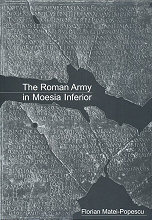
MATEI-POPESCU : The Roman army in Moesia Inferior (előszó)
A decade ago, I proposed Florian Matei-Popescu, young graduate of the Faculty of History with the University of Bucharest, to prepare an advanced studies (MA) thesis on the auxiliary units from Moesia Inferior. The author agreed that the history of the Roman army is a research field that clearly would never be exhausted, as new discoveries and studies of military history would persistently come to its completion. The result was an excellent study, which I immediately proposed for issue to SCIVA journal (52–53, 2001–2002, p. 173–242). Almost concurrently, I edited a book on the auxiliary units from Roman Dacia (Auxilia Daciae. Contributie la istoria militară a Daciei romane, Bucharest, 2002).
The sudden large amount of military diplomas, many coming from the Danubian provinces, aided to a constant update of troops' repertoire from Dacia and Moesia. The scientific expertise of the young researcher encouraged me to propose the draft of a doctoral thesis on the Roman army from Moesia Inferior.
Additionally, the ampleness and subject tackled by Fl. Matei-Popescu were novel. The historical specialty literature included insofar partial approaches. Thus, the Bulgarian scholar Bogdan Filow published a book entitled Die Legionen der Provinz Moesia von Augustus bis auf Diokletian (Klio, Beiheft VI, Leipzig, 1906). After seven decades, a new synthesis would be drawn up: Andrei Aricescu, Armata în Dobrogea romană (Bucharest, 1977); as per the title, the book discussed the military forces – legions and auxiliaries – from a certain area, in truth, the most important of the limes (the Romanian sector of the Danube), including however significant references to the history of the entire province; moreover, the book presents the history of the military defence of this territory in late Roman period, when the region formed the province of Scythia, resulted following the division of Moesia Inferior. Obviously, epigraphic finds and general studies of Roman military history went beyond this book.
On July 6, 2009, Fl. Matei-Popescu defended his thesis with the Faculty of History, in the presence of a demanding board formed of professors Alexandru Barnea, Ioan Piso and Alexandru Suceveanu. Upon commendatory appreciations in both my evaluation, drafted as scientific supervisor and that of the three reviewers, the candidate was awarded the title of doctor in history, summa cum laude.
Parallel to the thesis preparation, Fl. Matei Popescu attended the courses of the Department of Classical Languages with the University of Bucharest, which confers him an unfortunately unenviable standing of rara avis in a world dominated by shallowness and desire for easy success.
I shall not detail herein the content of this book, as the author himself does at length and better. It is absolutely notable that this book is published in an international language, thus concurring to its large dissemination within scholar environments.
Additionally to the author, I believe this book contributes to a Military History of Moesia; such title extension encloses the hope that another researcher, maybe even Fl. Matei Popescu, shall prepare a history of the Roman army from Moesia Superior. However, the military history in question should comprise other considerations as well: organization of the defensive system (limes) by the Lower Danube; the weaponry of the Roman soldiers from Moesia; the religion of the soldiers from the two provinces of Moesia; the monetary circulation in the forts from the Moesian limes; the wares in the Roman forts on the limes; the daily life in the forts on the Moesian limes etc.
Fl. Matei-Popescu's book would hopefully inaugurate such a series. Its forthcoming compels us to leave aside other concerns and proceed with the draft of a Roman army history from Dacia.
I express no doubts that the book will be welcomed by the researchers of the Roman military history. Nevertheless, upon the book issue, the author must recognize he is only at the beginning of a road, of a life dedicated to science. His work is like a monumental edifice, whose construction the architect alludes himself to finish even if by the end of his life.
On various occasions, I was glad to hear my colleagues some, ones of the most demanding professionals, saying that Fl. Matei-Popescu is one of the most remarkable representatives of his generation. I am happy that some of them were my students, some drafting doctoral thesis to my suggestion and supervision. I believe their involvement in historical research shall endure more than my few historical opera.
Fl. Matei-Popescu has many reasons to be happy. Even in difficult times like these, he earned a respected place in a prestigious institution like the Institute of Archaeology in Bucharest. His joy grew this spring, when his adorable daughter Ilinca was born. Let him remember that his accomplishments are due to the Divine Grace and let him ask everyday our Lord for health and efficiency.
CONSTANTIN C. PETOLESCU